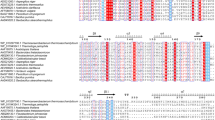Abstract
A putative α-L-arabinofuranosidase (AFase) gene belonging to family 51 of glycosyl hydrolases of a hyperthermophilic bacterium Thermotoga maritima MSB8 was cloned, sequenced, and overexpressed in Escherichia coli. The recombinant protein (Tm-AFase) was purified to apparent homogeneity by heat treatment (80°C, 30 min), followed by hydrophobic interaction, anion-exchange, and gel permeation column chromatography. Tm-AFase had a molecular mass of 55,284 Da on matrix assisted laser desorption ionization time-of-flight mass spectrometry and ~332 kDa on gel permeation column chromatography. Therefore, Tm-AFase comprised six identical subunits as in the case of homologous AFase from Geobacillus stearothermophilus. Regarding substrate specificity, Tm-AFase was active with p-nitrophenyl α-L-arabinofuranoside but not with p-nitrophenyl α-L-arabinopyranoside. Regarding polysaccharides, Tm-AFase hydrolyzed arabinan and debranched arabinan but not arabinoxylan, arabinogalactan, and carboxymethyl cellulose. Tm-AFase was extremely thermophilic, displaying an optimal reaction temperature of 90°C in a 10 min assay. When Tm-AFase was heated at 90°C, no loss of activity was observed for at least 24 h. At 100°C, the activity dropped to ~50% in 20 min; thereafter, inactivation occurred very slowly exhibiting a half-life of ~2.7 h, characterizing the enzyme to be the most thermophilic AFase reported thus far.




Similar content being viewed by others
Abbreviations
- AFase:
-
α-L-Arabinofuranosidase
- DTT:
-
Dithiothreitol
- GH-51:
-
Glycosyl hydrolase family 51
- Gs-AFase:
-
α-L-Arabinofuranosidase from Geobacillus stearothermophilus
- pNP:
-
p-nitrophenyl
- Tm-AFase:
-
α-L-Arabinofuranosidase from Thermotoga maritima MSB8
References
Beylot MH, McKie VA, Voragen AG, Doeswijk-Voragen CH, Gilbert HJ (2001) The Pseudomonas cellulosa glycoside hydrolase family 51 arabinofuranosidase exhibits wide substrate specificity. Biochem J 358:607–614
Bronnenmeier K, Kern A, Liebl W, Staudenbauer WL (1995) Purification of Thermotoga maritima enzymes for the degradation of cellulosic materials. Appl Environ Microbiol 61:1399–1407
Debeche T, Cummings N, Connerton I, Debeire P, O‘Donohue MJ (2000) Genetic and biochemical characterization of a highly thermostable α-L-arabinofuranosidase from Thermobacillus xylanilyticus. Appl Environ Microbiol 66:1734–1736
Gilead S, Shoham Y (1995) Purification and characterization of α-L-arabinofuranosidase from Bacillus stearothermophilus T-6. Appl Environ Microbiol 61:170–174
Hövel K, Shallom D, Niefind K, Belakhov V, Shoham G, Baasov T, Shoham Y, Schomburg D (2003) Crystal structure and snapshots along the reaction pathway of a family 51 α-L-arabinofuranosidase. EMBO J 22:4922–4932
Huber R, Langworthy TA, König H, Thomm M, Woese CR, Sleytr UB, Stetter KO (1986) Thermotoga maritima sp. nov. represents a new genus of unique extremely thermophilic eubacteria growing up to 90°C. Arch Microbiol 144:324–333
Liebl W, Stemplinger I, Ruile P (1997) Properties and gene structure of the Thermotoga maritima α-amylase AmyA, a putative lipoprotein of a hyperthermophilic bacterium. J Bacteriol 179:941–948
Meissner K, Wassenberg D, Liebl W (2000) The thermostabilizing domain of the modular xylanase XynA of Thermotoga maritima represents a novel type of binding domain with affinity for soluble xylan and mixed-linkage β-1,3/β-1,4-glucan. Mol Microbiol 36:898–912
Miller GL (1959) Use of dinitrosalicylic acid reagent for determination of reducing sugar. Anal Chem 31:426–428
Miyanaga A, Koseki T, Matsuzawa H, Wakagi T, Shoun H, Fushinobu S (2004) Crystal structure of a family 54 α-L-arabinofuranosidase reveals a novel carbohydrate-binding module that can bind arabinose. J Biol Chem 279:44,907–44,914
Nelson KE, Clayton RA, Gill SR, Gwinn ML, Dodson RJ, Haft DH, Hickey EK, Peterson JD, Nelson WC, Ketchum KA, McDonald L, Utterback TR, Malek JA, Linher KD, Garrett MM, Stewart AM, Cotton MD, Pratt MS, Phillips CA, Richardson D, Heidelberg J, Sutton GG, Fleischmann RD, Eisen JA, Fraser CM (1999) Evidence for lateral gene transfer between Archaea and bacteria from genome sequence of Thermotoga maritima. Nature 399:323–329
Raasch C, Streit W, Schanzer J, Bibel M, Gosslar U, Liebl W (2000) Thermotoga maritima AglA, an extremely thermostable NAD+ -, Mn2+ -, and thiol-dependent α-glucosidase. Extremophiles 4:189–200
Ruile P, Winterhalter C, Liebl W (1997) Isolation and analysis of a gene encoding α-glucuronidase, an enzyme with a novel primary structure involved in the breakdown of xylan. Mol Microbiol 23:267–279
Ruttersmith LD, Daniel RM (1993) Thermostable β-glucosidase and β-xylosidase from Thermotoga sp. strain FjSS3-B.1. Biochim Biophys Acta 1156:167–172
Salles BC, Cunha RB, Fontes W, Sousa MV, Filho EX (2000) Purification and characterization of a new xylanase from Acrophialophora nainiana. J Biotechnol 81:199–204
Shallom D, Belakhov V, Solomon D, Gilead-Gropper S, Baasov T, Shoham G, Shoham Y (2002a) The identification of the acid-base catalyst of α-arabinofuranosidase from Geobacillus stearothermophilus T-6, a family 51 glycoside hydrolase. FEBS Lett 514:163–167
Shallom D, Belakhov V, Solomon D, Shoham G, Baasov T, Shoham Y (2002b) Detailed kinetic analysis and identification of the nucleophile in α-L-arabinofuranosidase from Geobacillus stearothermophilus T-6, a family 51 glycoside hydrolase. J Biol Chem 277:43,667–43,673
Suresh C, Kitaoka M, Hayashi K (2003) A thermostable non-xylanolytic α-glucuronidase of Thermotoga maritima MSB8. Biosci Biotechnol Biochem 67:2359–2364
Winterhalter C, Liebl W (1995) Two extremely thermostable xylanases of the hyperthermophilic bacterium Thermotoga maritima MSB8. Appl Environ Microbiol 61:1810–1815
Xue Y, Shao W (2004) Expression and characterization of a thermostable β-xylosidase from the hyperthermophile, Thermotoga maritima. Biotechnol Lett 26:1511–1515
Author information
Authors and Affiliations
Corresponding author
Additional information
Communicated by K. Horikoshi
Rights and permissions
About this article
Cite this article
Miyazaki, K. Hyperthermophilic α-L-arabinofuranosidase from Thermotoga maritima MSB8: molecular cloning, gene expression, and characterization of the recombinant protein. Extremophiles 9, 399–406 (2005). https://doi.org/10.1007/s00792-005-0455-2
Received:
Accepted:
Published:
Issue Date:
DOI: https://doi.org/10.1007/s00792-005-0455-2



